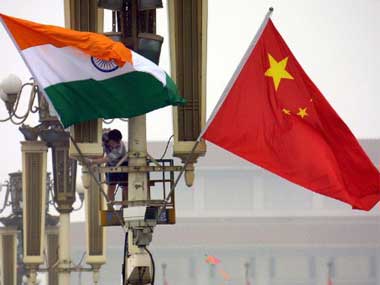“All warfare is based on deception. Hence, when we are able to attack, we must seem unable; when using our forces, we must appear inactive; when we are near, we must make the enemy believe we are far away; when far away, we must make him believe we are near,” or so said general Sun Tzu in his oft-quoted The Art of War. [caption id=“attachment_3081944” align=“alignleft” width=“380”] Representational image. AFP[/caption] It may seem lazy analysis to keep going back to an ancient Chinese military treatise to explain the dragon’s myriad moves, but Sunzi’s work remains one of the key guiding principles of Chinese foreign policy even today. The face-off in Ladakh since Wednesday, where People’s Liberation Army crossed the Line of Actual Control (LAC) and “forcefully” stopped the construction work of an irrigation canal, has been described in Indian media as yet another example of Chinese bullying. But such an interpretation would be misleading. The Ladakh incursion is neither an example of Chinese imperialism nor an indication of Beijing’s nervousness over a civil construction project, though that is exactly the impression China wants to cast. Rather it’s a disguised attempt to gain leverage points at the crucial National Security Advisor (NSA)-level talks on Friday between Ajit Doval and his Chinese counterpart Yang Jiechi in Hyderabad. And that is also the reason why, despite reports emerging of an incursion and aggressive behaviour from the Chinese People’s Liberation Army (PLA) — around 55 of whom “took position” along the fuzzy LAC in Ladakh’s Demchok sector — the Indian army and the civil administration have sought to play down the incident. The Chinese claim, that either side needs to take permission for construction work near the “disputed” border, is hogwash. Under the existing set of agreements and protocols nothing stops India from digging a canal and linking a hot spring to a nearby village under the rural employment scheme. New Delhi is also not obliged to share information with China over civil infrastructural projects. The irony of China protesting against an alleged violation of agreement won’t be lost on anyone. From the “Nine-Dash Line” on South China Sea, construction of China Pakistan Economic Corridor through Pakistan-occupied-Kashmir to building a host of civil-military infrastructural projects on the Tibetan plateau, China has shown scant regard for international rules, laws and arbitration. Daily Mail
points out that China is building a railway line by 2020 from Chengdu (Sichuan) to Lhasa which will reach the Indian border. Another railway line to Kyirong and Nepal probably to be continued till Kathmandu and Lumbini is on anvil. A second international airport in Lhasa, a new airport in Nagchu, a four-lane highway between Lhasa and Nyingchi (Arunachal border) are also coming up. “And finally the improvement of NH 219 between Tibet and Xinjiang, cutting across Indian territory in the Aksai Chin area of Ladakh. All these projects have serious strategic implications for India, as the infrastructure built on the plateau has a dual use: civilian and military,” says the report. India has not been sitting idle either. The government informed the Parliament last July that 73 roads of operational significance are being built along the Sino-Indian border by 2020. Chinese commentators writing for Indian publications have pointed out that Beijing is “worried” about India’s show of strength along the border that includes deployment of 120 tanks in Ladakh, conveniently forgetting China’s persistent and aggressive arms buildup over the years. Hence we find a senior Army officer telling
Times of India that there was “no Chinese incursion across LAC. The issues relating to construction projects on both sides of LAC are being resolved in border personnel meetings and flag meetings”.
#EasternLadakh. No Chinese incursion across LAC. Issues relating construction projects on both sides of LAC being resolved in #BPM @adgpi
— NORTHERN COMMAND - INDIAN ARMY (@NorthernComd_IA) November 3, 2016
Not just that, later in the day MEA spokesperson Vikas Swarup denied having any information of any incursion with a caveat that were such a thing to happen, it will be handled through “established mechanism”. He urged the media not to “sensationalise it”. What’s happening here? The crux of the territorial tango is that both powers are fully aware of each other’s moves and with the deftness of ballerinas, are playing along the script. [caption id=“attachment_3088606” align=“alignright” width=“380”] China’s State Councilor Yang Jiechi (L) and India’s National Security Advisor Ajit Doval. Reuters[/caption] But that doesn’t mean the incursion didn’t happen. It did. Therefore, the right question to ask is what leverages are the Chinese aiming for with such a manouvre? The answer lies in the recent quagmire that Sino-Indian relationship has fallen into, and the ongoing talks in Hyderabad between National Security Advisor Ajit Doval and his Chinese counterpart Yang Jiechi that are expected to address some of the fractious issues. Chinese reasoning is simple. If India raises contentious points it will be beneficial for China to hold as many cards as possible up its sleeves. A series of measures and counter-measures has seen a loss of confidence between the two Asian giants to the extent that China recently removed the last fig leaf on blocking India’s NSG membership, making it quite clear that it won’t back New Delhi’s bid unless a rule to include other non-NPT members (read Pakistan) is formulated. It also remains adamant on not letting Jaish-e-Mohammed (JeM) chief Masood Azhar be designated as a terrorist by the United Nations, a key Indian demand. The Ladakh incursion is one move in the game of geopolitical chess that allows China the room to anticipate and blunt India’s points of dissidence. It also simultaneously escalates Beijing’s displeasure over India’s decision to allow The Dalai Lama to visit Arunachal Pradesh and a popular movement in India to boycott Chinese goods. When two nations as big and influential as China and India engage, the subtext is far more important than the printed lines.


)

)
)
)
)
)
)
)
)



